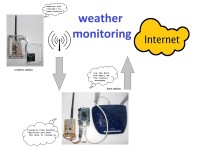10Km SubGHz RadioTransceiver with Energy Harvesting Power Supply

A wireless sensor networks(WSN) and Ιnternet of Τhinks(IoT) probe.
Yes it's true. The communication between transmitter and receiver is absolutely stable at more than 10 Km (line of sight) distances. And all this with just 10dBm output from the internal (single chip processor and RF radio) power amplifier.
The project is based on two amazing chips from Analog Devices .The ADP5090 and ADuCRF101 has been designed to used on autonomous systems(remote data collection and then wireless transmission of these data).
The ADP5090 is an integrated boost regulator that converts dc power from PV cells or TEGs. The device charges storage elements such as rechargeable Li-Ion batteries, thin film batteries, super capacitors, and conventional capacitors, and powers up small electronic devices and battery-free systems. The ADP5090 provides efficient conversion of the harvested limited power from a 16 μW to 200 mW.
The ADuCRF101 is a fully integrated single chip data acquisition solution designed for low power wireless applications. It features a 12-bit ADC, a low power Cortex™-M3 processor from ARM®, a 431 MHz to 464 MHz and 862 MHz to 928 MHz RF transceiver, and Flash/EE memory packaged in a 9 mm × 9 mm LFCSP.
I have designed two cards based on these chips.
The first pcb is an energy harvesting power supply. I use a 2V solar panel with 60ma peak output. The photovoltaic panel charging a 3,7V 700mAh Li-ion battery. The output from the solar panel and the battery drives a ADP190 (linear voltage regulator) which finally gives us 3.3V stable output.
The second pcb is designed around ADuCRF101. This card can be supplied with energy from the first card(ADP5090 pcb). So totally we can have an energy-autonomous system. It has been manufactured so that it is possible for us to experiment with the power amplifier of the RF transmitter (Single-ended or differential PA configuration). The card can work either as a receiver or as transmitter or as a transceiver. The loaded firmware could make the difference.
Currently I have built two code files.
The 'Transmitter code' firmware converts the card into a transmitter who continuously emits the message "hello world". One message a second. The on board red led lights up after each transmission.
The 'Receiver code' firmware converts the card into a receiver who constantly listens the air for a message. The on board red led lights up after each successfully message reception(CRC correct).
I use these cards to measure the maximum transmission distance.
To download the code into the cards you have to use the jtag adapter from the 150210 ELEKTOR project.
These two cards can be used as a starting point for many experiments and applications around the autonomous wireless transmission systems.
Have a nice experimentation.
The project is based on two amazing chips from Analog Devices .The ADP5090 and ADuCRF101 has been designed to used on autonomous systems(remote data collection and then wireless transmission of these data).
The ADP5090 is an integrated boost regulator that converts dc power from PV cells or TEGs. The device charges storage elements such as rechargeable Li-Ion batteries, thin film batteries, super capacitors, and conventional capacitors, and powers up small electronic devices and battery-free systems. The ADP5090 provides efficient conversion of the harvested limited power from a 16 μW to 200 mW.
The ADuCRF101 is a fully integrated single chip data acquisition solution designed for low power wireless applications. It features a 12-bit ADC, a low power Cortex™-M3 processor from ARM®, a 431 MHz to 464 MHz and 862 MHz to 928 MHz RF transceiver, and Flash/EE memory packaged in a 9 mm × 9 mm LFCSP.
I have designed two cards based on these chips.
The first pcb is an energy harvesting power supply. I use a 2V solar panel with 60ma peak output. The photovoltaic panel charging a 3,7V 700mAh Li-ion battery. The output from the solar panel and the battery drives a ADP190 (linear voltage regulator) which finally gives us 3.3V stable output.
The second pcb is designed around ADuCRF101. This card can be supplied with energy from the first card(ADP5090 pcb). So totally we can have an energy-autonomous system. It has been manufactured so that it is possible for us to experiment with the power amplifier of the RF transmitter (Single-ended or differential PA configuration). The card can work either as a receiver or as transmitter or as a transceiver. The loaded firmware could make the difference.
Currently I have built two code files.
The 'Transmitter code' firmware converts the card into a transmitter who continuously emits the message "hello world". One message a second. The on board red led lights up after each transmission.
The 'Receiver code' firmware converts the card into a receiver who constantly listens the air for a message. The on board red led lights up after each successfully message reception(CRC correct).
I use these cards to measure the maximum transmission distance.
To download the code into the cards you have to use the jtag adapter from the 150210 ELEKTOR project.
These two cards can be used as a starting point for many experiments and applications around the autonomous wireless transmission systems.
Have a nice experimentation.



Updates van de auteur